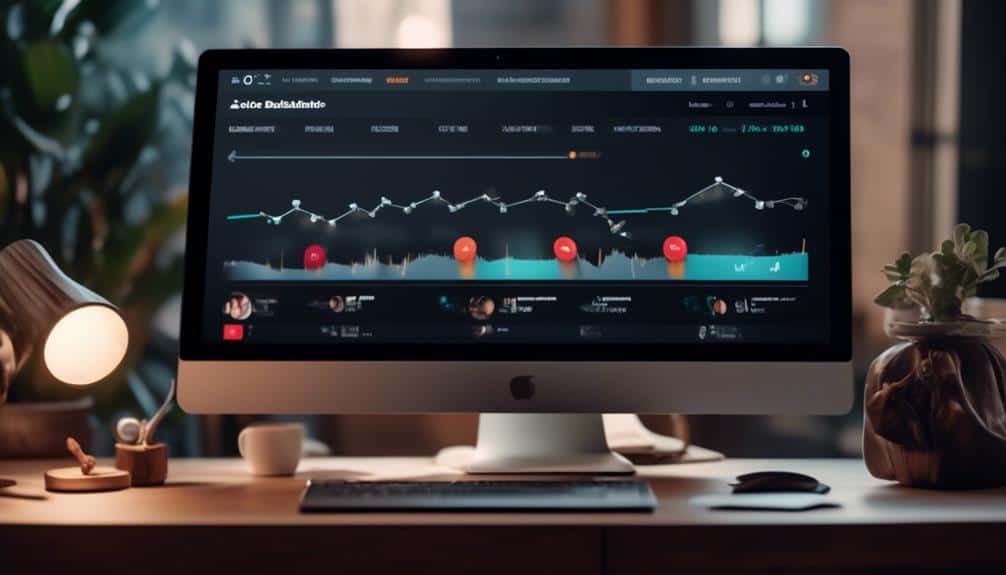Hurry: Explore the Future of Email Marketing With Dynamic and Personalized Content!
Imagine a world where every email you receive feels like it was crafted just for you – tailored to your interests, preferences, and needs. Gone are the days of generic, one-size-fits-all messages cluttering your inbox. Instead, you open your email to find captivating content that captures your attention and compels you to take action.
This is the future of email marketing, where dynamic and personalized content reigns supreme. But how exactly does it work? And why is it so important for businesses like yours?
In this discussion, we will explore the exciting possibilities of dynamic email marketing, discover the key benefits it brings, and learn how you can implement it in your own campaigns. Get ready to revolutionize your email marketing strategy and unlock new levels of engagement and conversion rates.
Key Takeaways
- Dynamic and personalized content in email marketing increases open and read rates
- Implementing interactive elements and timely, relevant content enhances the overall customer experience
- Segmenting email lists and using dynamic tags personalize emails for a more engaging and interactive experience
- Measuring metrics such as open rate, click-through rate, and conversion rate helps optimize and evaluate the success of dynamic email marketing campaigns.
Why Dynamic and Personalized Content Matters

Dynamic and personalized content matters because it allows you to create targeted and relevant email marketing campaigns that effectively engage your audience. By personalizing your emails, you can tailor the content to the specific needs and interests of each individual recipient. This level of personalization not only increases the likelihood of your emails being opened and read, but also enhances the overall customer experience.
The benefits of personalization are numerous. Firstly, it helps to build trust and loyalty with your audience. When recipients receive emails that are personalized to their preferences, they feel valued and understood, which in turn fosters a stronger connection to your brand.
Secondly, personalization allows you to provide relevant and timely content to your audience. By utilizing data and insights about your subscribers, you can send them targeted offers, recommendations, and updates that are most likely to resonate with them.
In addition to personalization, dynamic content also plays a crucial role in email marketing. Dynamic content refers to elements within an email that can change based on the recipient's behavior, preferences, or other factors. This can include personalized product recommendations, tailored offers, or even dynamic subject lines. By incorporating dynamic content, you can create a more engaging and interactive experience for your audience, increasing the impact of your email campaigns.
Key Benefits of Using Dynamic Emails
Using dynamic emails in your email marketing campaigns can have significant benefits for your business.
Firstly, dynamic emails can greatly increase engagement rates by delivering personalized and relevant content to your recipients. This level of personalization not only captures their attention but also encourages them to interact with your email.
Additionally, dynamic emails have been shown to improve conversion rates by providing tailored product recommendations or exclusive offers that are more likely to resonate with your audience.
Increased Engagement Rates
Experience higher levels of customer interaction and response by leveraging the power of personalized and dynamic email content.
By tailoring your emails to each individual recipient, you can create a more personalized customer experience that resonates with their specific needs and interests. This level of customization not only increases customer loyalty, but also encourages higher engagement rates.
When customers feel that you understand their preferences and are addressing their unique concerns, they're more likely to open your emails, click on your links, and take action.
Dynamic content allows you to deliver relevant and timely information, ensuring that your messages are always fresh and engaging.
Improved Conversion Rates
To further enhance your email marketing efforts, consider the significant boost in conversion rates that can be achieved through the strategic use of dynamic content. By personalizing your email campaigns, you can tailor your messages to individual recipients, increasing the likelihood of them taking action.
This targeted approach leads to improved conversion rates, which directly translates into increased sales for your business. When customers receive emails that are relevant to their interests and preferences, they're more likely to make a purchase.
Additionally, dynamic content allows you to build customer loyalty by creating a personalized experience for each recipient. By showing that you understand their needs and preferences, you can build trust and encourage repeat business.
Don't miss out on the opportunity to drive higher conversions and build customer loyalty with dynamic email content.
How to Implement Dynamic and Personalized Content

Enhance your email marketing campaigns by incorporating dynamic and personalized content that captivates your audience from the moment they open their inbox. Implementing dynamic content and effective personalization strategies can significantly improve your email marketing efforts, resulting in higher engagement and conversion rates.
To implement dynamic content, start by segmenting your email list based on customer preferences, demographics, and past behaviors. This allows you to create targeted and relevant content that resonates with each segment. Use dynamic tags to personalize the subject line and body of your emails, addressing recipients by name and including personalized recommendations based on their previous purchases or browsing history.
Another effective strategy is to leverage real-time data to deliver timely and personalized content. For example, you can send automated emails triggered by specific actions, such as abandoned cart reminders or personalized product recommendations based on recent website visits.
Furthermore, consider incorporating interactive elements into your emails, such as polls, quizzes, or interactive product showcases. This not only increases engagement but also provides valuable insights into customer preferences and interests.
Remember to regularly analyze and optimize your email campaigns based on performance metrics such as open rates, click-through rates, and conversion rates. This allows you to continually refine your content and personalization strategies to provide the most relevant and engaging experience for your audience.
Best Practices for Creating Engaging Email Content
Implement these key strategies to create engaging email content that captivates your audience and drives conversions.
When it comes to content personalization strategies, it's crucial to understand your audience and tailor your emails accordingly. Start by segmenting your email list based on demographics, behavior, or past purchase history. This allows you to send targeted emails that speak directly to the interests and needs of each segment.
To overcome technical limitations and ensure that your email content is engaging, it's important to optimize your emails for different devices and email clients. Use responsive design to ensure that your emails look great on both desktop and mobile devices. Keep your email design clean and simple, with clear calls to action and easy-to-read fonts.
Another best practice for creating engaging email content is to use dynamic and personalized elements. Incorporate the recipient's name in the subject line or the email opening to grab their attention. Use dynamic content blocks to display different content based on the recipient's preferences or previous interactions with your brand.
Tools and Platforms for Dynamic Email Marketing

Are you looking to take your email marketing to the next level?
With the right tools and platforms, you can automate personalization, ensuring that each email feels tailored to the recipient.
Real-time content updates allow you to deliver relevant and up-to-date information, while dynamic data integration enables you to seamlessly incorporate customer data into your emails.
Let's explore the power of these tools and platforms for dynamic email marketing.
Automation for Personalization
To improve the effectiveness of your email marketing campaigns, consider utilizing automation tools and platforms that enable dynamic and personalized content. Automation strategies and personalization techniques go hand in hand, allowing you to tailor your emails to individual recipients based on their preferences, behaviors, and demographics.
By using automation, you can send timely and relevant emails at scale, saving time and effort while still delivering a personalized experience. Automation tools can help you segment your email list, automate email sequences, and even dynamically insert personalized content such as product recommendations or tailored offers.
Platforms like Mailchimp, Klaviyo, and ActiveCampaign offer robust automation features that empower you to create highly personalized email campaigns that resonate with your audience. With automation for personalization, you can take your email marketing to the next level and achieve better engagement and conversion rates.
Real-Time Content Updates
Looking for tools and platforms to achieve real-time content updates in your dynamic email marketing campaigns? Look no further!
Real-time content generation is an essential aspect of personalized email templates, allowing you to deliver timely and relevant messages to your audience.
By utilizing the right tools and platforms, you can dynamically update your email content based on user actions or external triggers. This means that your subscribers receive the most up-to-date information, increasing engagement and conversion rates.
With real-time content updates, you can showcase limited-time offers, countdown timers, and personalized recommendations, creating a sense of urgency and driving action.
Invest in tools and platforms that offer seamless integration with your email marketing software, ensuring a smooth and efficient workflow.
Don't miss out on the opportunity to captivate your audience with real-time content updates in your email campaigns!
Dynamic Data Integration
For seamless and efficient dynamic email marketing, utilize tools and platforms that enable dynamic data integration. By implementing dynamic content, you can personalize your emails and engage your audience on a deeper level.
Here are three key tools and platforms to consider:
- Email Service Providers (ESPs): Choose an ESP that offers robust data integration capabilities, allowing you to seamlessly connect your data sources and automate personalized content.
- Customer Relationship Management (CRM) Systems: Integrate your CRM system with your email marketing platform to access valuable customer data and create highly targeted and relevant email campaigns.
- Marketing Automation Platforms: These platforms enable you to automate the delivery of personalized emails based on specific triggers and user behavior, ensuring timely and relevant communication.
Case Studies: Successful Dynamic Email Campaigns

Successful dynamic email campaigns have proven to be highly effective in engaging and converting customers. By incorporating personalized and relevant content, businesses have seen significant improvements in their email marketing efforts. Let's take a look at a few successful case studies and the effective strategies they implemented.
One case study comes from a clothing retailer who used dynamic email campaigns to target customers based on their browsing history. By sending personalized product recommendations, they were able to increase their click-through rates by 50% and boost their conversion rates by 30%.
Another case study involves an e-commerce platform that utilized dynamic content to showcase products that were recently viewed or added to the cart. This strategy resulted in a 25% increase in revenue and a 20% decrease in cart abandonment.
A travel agency also saw success with their dynamic email campaigns. They used location-based targeting to send personalized offers to customers interested in specific destinations. This approach led to a 35% increase in bookings and a 40% increase in customer engagement.
These successful case studies highlight the power of dynamic email campaigns in driving customer engagement and conversions. By leveraging effective strategies and delivering personalized content, businesses can enhance their email marketing efforts and achieve remarkable results.
Overcoming Challenges in Dynamic Email Marketing
Are you struggling with technical limitations in personalizing your email marketing campaigns?
Overcoming these challenges is crucial for delivering relevant and engaging content to your subscribers.
Technical Limitations in Personalization
Overcoming the technical limitations in personalization is essential for achieving dynamic and engaging email marketing campaigns. In today's fast-paced digital world, customers expect emails tailored specifically to their needs and preferences. However, there are challenges that marketers face when it comes to personalizing emails on a large scale.
To overcome these limitations, consider the following strategies:
- Implement advanced data analytics tools to gather and analyze customer data effectively.
- Utilize dynamic content platforms that enable you to create personalized email templates and automate the process of tailoring messages.
- Invest in robust email marketing software that supports advanced personalization features, such as dynamic content insertion and conditional logic.
Strategies for Content Personalization
To optimize your email marketing campaigns and deliver personalized content, it's crucial to implement effective strategies that overcome the challenges of dynamic email marketing.
One such strategy is content segmentation, which involves dividing your audience into distinct groups based on their demographics, interests, or behaviors. By segmenting your audience, you can tailor your email content to their specific needs and preferences, increasing the chances of engagement and conversion.
Additionally, personalized recommendations are another powerful strategy for content personalization. By analyzing your subscribers' past interactions and purchase history, you can provide them with relevant product recommendations that are tailored to their interests. This not only enhances the customer experience but also boosts your chances of generating sales.
Measuring the Success of Dynamic Email Campaigns

Measuring the success of your dynamic email campaigns is crucial to understanding their impact and optimizing future campaigns. By tracking metrics and measuring effectiveness, you can gauge the effectiveness of your email marketing efforts and make data-driven decisions to improve your campaigns.
Here are three key reasons why measuring the success of your dynamic email campaigns is essential:
- Optimize engagement: Measuring the open rate, click-through rate, and conversion rate of your dynamic email campaigns helps you understand how engaging your content is. By analyzing these metrics, you can identify what resonates with your audience and optimize your email content to drive higher engagement.
- Improve personalization: Tracking metrics such as segmentation and personalization effectiveness allows you to assess how well you're targeting your audience. Measuring the success of dynamic elements, like personalized product recommendations or tailored offers, helps you refine your strategies and deliver more relevant and personalized content to your customers.
- Drive ROI: Measuring the success of your dynamic email campaigns enables you to assess their impact on your bottom line. By tracking metrics like revenue generated and ROI, you can determine the effectiveness of your campaigns in driving conversions and sales. This information empowers you to allocate your resources wisely and focus on strategies that deliver the highest return on investment.
Future Trends in Dynamic Email Marketing
As technology continues to evolve, dynamic email marketing is expected to see several exciting trends emerge in the future.
One of the key future innovations in dynamic email marketing is the advancement in personalization. Marketers will have the ability to create highly personalized and targeted email campaigns based on customer segmentation. This means that each recipient will receive content that's tailored specifically to their interests, preferences, and behaviors.
Another trend that's expected to shape the future of dynamic email marketing is the integration of artificial intelligence (AI) and machine learning. AI-powered algorithms will enable marketers to analyze vast amounts of data and generate insights that can be used to create more effective and relevant email campaigns. By leveraging AI, marketers can automate the process of segmenting customers and delivering personalized content, resulting in higher engagement and conversion rates.
Furthermore, the future of dynamic email marketing will also see the rise of interactive and immersive content. With advancements in technology, email campaigns can go beyond simple text and images to include interactive elements such as quizzes, polls, and videos. This not only enhances the user experience but also increases engagement and encourages recipients to take action.
Getting Started With Dynamic Email Content

Ready to take your email marketing to the next level? Learn how to get started with dynamic email content and captivate your audience with personalized and interactive campaigns.
Here are some helpful tips to get you started:
- Segment your audience: One common mistake is sending the same email to all subscribers. By segmenting your audience based on demographics, preferences, and behavior, you can tailor your content to their specific needs and interests. This personalization will make your emails more relevant and engaging.
- Use dynamic content blocks: Another mistake is sending static emails that don't change based on the recipient. With dynamic content blocks, you can display different images, offers, or product recommendations depending on the recipient's past interactions with your brand. This level of personalization will make your emails more compelling and increase conversion rates.
- Test and optimize: Don't settle for mediocre results. Continuously test your email campaigns to see what works best for your audience. Experiment with different subject lines, calls to action, and layouts. Use A/B testing to compare different versions of your emails and optimize them for better performance.
Frequently Asked Questions
How Can Dynamic and Personalized Content in Emails Improve Customer Engagement and Conversion Rates?
By incorporating dynamic and personalized content in your emails, you can significantly improve customer engagement and conversion rates. Personalization benefits include increased relevancy, stronger customer relationships, and higher open and click-through rates. Follow best practices to create compelling and tailored email content.
What Are the Key Factors to Consider When Implementing Dynamic and Personalized Content in Email Marketing Campaigns?
When implementing dynamic and personalized content in email marketing campaigns, factors to consider include audience segmentation, data analysis, and testing. Best practices involve crafting compelling subject lines, personalizing content based on customer preferences, and optimizing for mobile devices.
Are There Any Specific Tools or Platforms That Are Recommended for Creating and Managing Dynamic Email Campaigns?
There are several email campaign tools and email personalization platforms available that can help you create and manage dynamic email campaigns. These tools make it easy to personalize content and engage your audience.
Can You Provide Examples of Successful Dynamic Email Campaigns and the Strategies They Used?
To see successful dynamic email campaigns and the strategies they used, you can look at companies like Amazon and Spotify. They personalize content based on user behavior and preferences, leading to higher engagement and conversion rates.
What Are Some Common Challenges Faced in Dynamic Email Marketing and How Can They Be Overcome?
Overcoming challenges in dynamic email marketing involves implementing best practices. By ensuring your content is relevant, personalized, and targeted, you can overcome issues like low engagement and deliver meaningful messages to your audience.
Conclusion
So don't wait any longer – embrace the power of dynamic and personalized content in your email marketing campaigns!
With its ability to engage and resonate with your audience on a deeper level, dynamic emails can significantly boost your conversion rates and drive customer loyalty.
By following best practices and utilizing the right tools and platforms, you can easily implement this innovative approach.
Stay ahead of the curve and start reaping the benefits of dynamic email marketing today!








